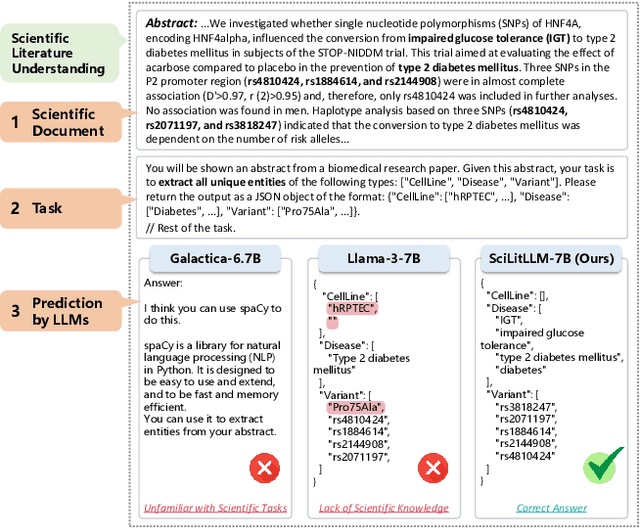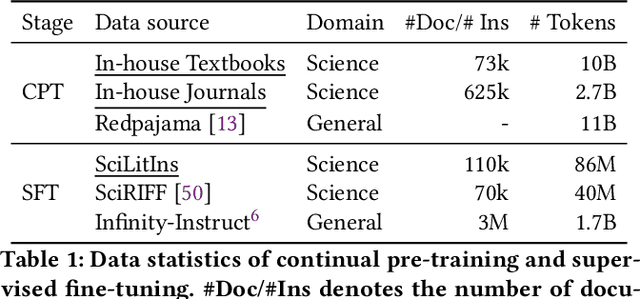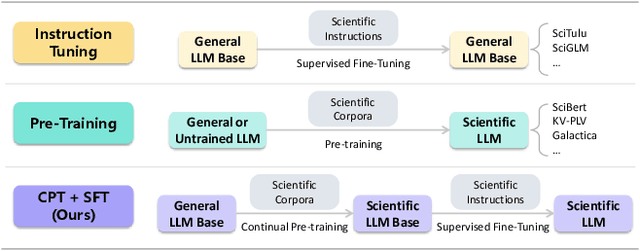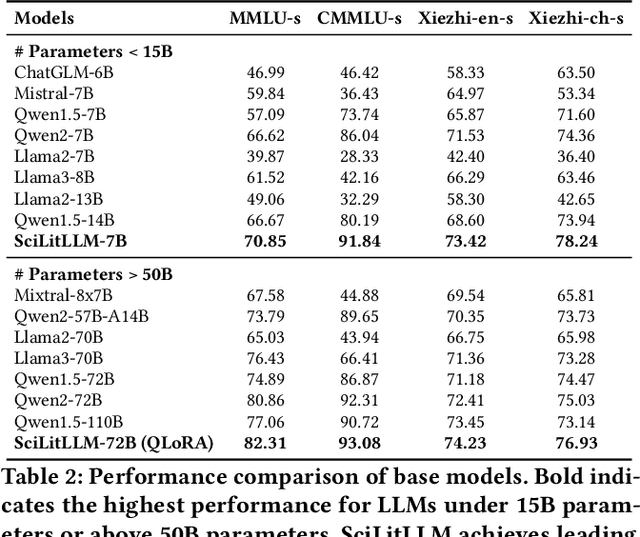Jin Huang
University of Notre Dame
Automatic MILP Model Construction for Multi-Robot Task Allocation and Scheduling Based on Large Language Models
Mar 18, 2025Abstract:With the accelerated development of Industry 4.0, intelligent manufacturing systems increasingly require efficient task allocation and scheduling in multi-robot systems. However, existing methods rely on domain expertise and face challenges in adapting to dynamic production constraints. Additionally, enterprises have high privacy requirements for production scheduling data, which prevents the use of cloud-based large language models (LLMs) for solution development. To address these challenges, there is an urgent need for an automated modeling solution that meets data privacy requirements. This study proposes a knowledge-augmented mixed integer linear programming (MILP) automated formulation framework, integrating local LLMs with domain-specific knowledge bases to generate executable code from natural language descriptions automatically. The framework employs a knowledge-guided DeepSeek-R1-Distill-Qwen-32B model to extract complex spatiotemporal constraints (82% average accuracy) and leverages a supervised fine-tuned Qwen2.5-Coder-7B-Instruct model for efficient MILP code generation (90% average accuracy). Experimental results demonstrate that the framework successfully achieves automatic modeling in the aircraft skin manufacturing case while ensuring data privacy and computational efficiency. This research provides a low-barrier and highly reliable technical path for modeling in complex industrial scenarios.
VRsketch2Gaussian: 3D VR Sketch Guided 3D Object Generation with Gaussian Splatting
Mar 16, 2025Abstract:We propose VRSketch2Gaussian, a first VR sketch-guided, multi-modal, native 3D object generation framework that incorporates a 3D Gaussian Splatting representation. As part of our work, we introduce VRSS, the first large-scale paired dataset containing VR sketches, text, images, and 3DGS, bridging the gap in multi-modal VR sketch-based generation. Our approach features the following key innovations: 1) Sketch-CLIP feature alignment. We propose a two-stage alignment strategy that bridges the domain gap between sparse VR sketch embeddings and rich CLIP embeddings, facilitating both VR sketch-based retrieval and generation tasks. 2) Fine-Grained multi-modal conditioning. We disentangle the 3D generation process by using explicit VR sketches for geometric conditioning and text descriptions for appearance control. To facilitate this, we propose a generalizable VR sketch encoder that effectively aligns different modalities. 3) Efficient and high-fidelity 3D native generation. Our method leverages a 3D-native generation approach that enables fast and texture-rich 3D object synthesis. Experiments conducted on our VRSS dataset demonstrate that our method achieves high-quality, multi-modal VR sketch-based 3D generation. We believe our VRSS dataset and VRsketch2Gaussian method will be beneficial for the 3D generation community.
Residual Learning towards High-fidelity Vehicle Dynamics Modeling with Transformer
Feb 17, 2025Abstract:The vehicle dynamics model serves as a vital component of autonomous driving systems, as it describes the temporal changes in vehicle state. In a long period, researchers have made significant endeavors to accurately model vehicle dynamics. Traditional physics-based methods employ mathematical formulae to model vehicle dynamics, but they are unable to adequately describe complex vehicle systems due to the simplifications they entail. Recent advancements in deep learning-based methods have addressed this limitation by directly regressing vehicle dynamics. However, the performance and generalization capabilities still require further enhancement. In this letter, we address these problems by proposing a vehicle dynamics correction system that leverages deep neural networks to correct the state residuals of a physical model instead of directly estimating the states. This system greatly reduces the difficulty of network learning and thus improves the estimation accuracy of vehicle dynamics. Furthermore, we have developed a novel Transformer-based dynamics residual correction network, DyTR. This network implicitly represents state residuals as high-dimensional queries, and iteratively updates the estimated residuals by interacting with dynamics state features. The experiments in simulations demonstrate the proposed system works much better than physics model, and our proposed DyTR model achieves the best performances on dynamics state residual correction task, reducing the state prediction errors of a simple 3 DoF vehicle model by an average of 92.3% and 59.9% in two dataset, respectively.
Revisiting Language Models in Neural News Recommender Systems
Jan 20, 2025Abstract:Neural news recommender systems (RSs) have integrated language models (LMs) to encode news articles with rich textual information into representations, thereby improving the recommendation process. Most studies suggest that (i) news RSs achieve better performance with larger pre-trained language models (PLMs) than shallow language models (SLMs), and (ii) that large language models (LLMs) outperform PLMs. However, other studies indicate that PLMs sometimes lead to worse performance than SLMs. Thus, it remains unclear whether using larger LMs consistently improves the performance of news RSs. In this paper, we revisit, unify, and extend these comparisons of the effectiveness of LMs in news RSs using the real-world MIND dataset. We find that (i) larger LMs do not necessarily translate to better performance in news RSs, and (ii) they require stricter fine-tuning hyperparameter selection and greater computational resources to achieve optimal recommendation performance than smaller LMs. On the positive side, our experiments show that larger LMs lead to better recommendation performance for cold-start users: they alleviate dependency on extensive user interaction history and make recommendations more reliant on the news content.
SEO: Stochastic Experience Optimization for Large Language Models
Jan 08, 2025Abstract:Large Language Models (LLMs) can benefit from useful experiences to improve their performance on specific tasks. However, finding helpful experiences for different LLMs is not obvious, since it is unclear what experiences suit specific LLMs. Previous studies intended to automatically find useful experiences using LLMs, while it is difficult to ensure the effectiveness of the obtained experience. In this paper, we propose Stochastic Experience Optimization (SEO), an iterative approach that finds optimized model-specific experience without modifying model parameters through experience update in natural language. In SEO, we propose a stochastic validation method to ensure the update direction of experience, avoiding unavailing updates. Experimental results on three tasks for three LLMs demonstrate that experiences optimized by SEO can achieve consistently improved performance. Further analysis indicates that SEO-optimized experience can generalize to out-of-distribution data, boosting the performance of LLMs on similar tasks.
Efficient Compression of Sparse Accelerator Data Using Implicit Neural Representations and Importance Sampling
Dec 02, 2024Abstract:High-energy, large-scale particle colliders in nuclear and high-energy physics generate data at extraordinary rates, reaching up to $1$ terabyte and several petabytes per second, respectively. The development of real-time, high-throughput data compression algorithms capable of reducing this data to manageable sizes for permanent storage is of paramount importance. A unique characteristic of the tracking detector data is the extreme sparsity of particle trajectories in space, with an occupancy rate ranging from approximately $10^{-6}$ to $10\%$. Furthermore, for downstream tasks, a continuous representation of this data is often more useful than a voxel-based, discrete representation due to the inherently continuous nature of the signals involved. To address these challenges, we propose a novel approach using implicit neural representations for data learning and compression. We also introduce an importance sampling technique to accelerate the network training process. Our method is competitive with traditional compression algorithms, such as MGARD, SZ, and ZFP, while offering significant speed-ups and maintaining negligible accuracy loss through our importance sampling strategy.
Variable Rate Neural Compression for Sparse Detector Data
Nov 18, 2024Abstract:High-energy large-scale particle colliders generate data at extraordinary rates. Developing real-time high-throughput data compression algorithms to reduce data volume and meet the bandwidth requirement for storage has become increasingly critical. Deep learning is a promising technology that can address this challenging topic. At the newly constructed sPHENIX experiment at the Relativistic Heavy Ion Collider, a Time Projection Chamber (TPC) serves as the main tracking detector, which records three-dimensional particle trajectories in a volume of a gas-filled cylinder. In terms of occupancy, the resulting data flow can be very sparse reaching $10^{-3}$ for proton-proton collisions. Such sparsity presents a challenge to conventional learning-free lossy compression algorithms, such as SZ, ZFP, and MGARD. In contrast, emerging deep learning-based models, particularly those utilizing convolutional neural networks for compression, have outperformed these conventional methods in terms of compression ratios and reconstruction accuracy. However, research on the efficacy of these deep learning models in handling sparse datasets, like those produced in particle colliders, remains limited. Furthermore, most deep learning models do not adapt their processing speeds to data sparsity, which affects efficiency. To address this issue, we propose a novel approach for TPC data compression via key-point identification facilitated by sparse convolution. Our proposed algorithm, BCAE-VS, achieves a $75\%$ improvement in reconstruction accuracy with a $10\%$ increase in compression ratio over the previous state-of-the-art model. Additionally, BCAE-VS manages to achieve these results with a model size over two orders of magnitude smaller. Lastly, we have experimentally verified that as sparsity increases, so does the model's throughput.
Automatic programming via large language models with population self-evolution for dynamic job shop scheduling problem
Oct 30, 2024Abstract:Heuristic dispatching rules (HDRs) are widely regarded as effective methods for solving dynamic job shop scheduling problems (DJSSP) in real-world production environments. However, their performance is highly scenario-dependent, often requiring expert customization. To address this, genetic programming (GP) and gene expression programming (GEP) have been extensively used for automatic algorithm design. Nevertheless, these approaches often face challenges due to high randomness in the search process and limited generalization ability, hindering the application of trained dispatching rules to new scenarios or dynamic environments. Recently, the integration of large language models (LLMs) with evolutionary algorithms has opened new avenues for prompt engineering and automatic algorithm design. To enhance the capabilities of LLMs in automatic HDRs design, this paper proposes a novel population self-evolutionary (SeEvo) method, a general search framework inspired by the self-reflective design strategies of human experts. The SeEvo method accelerates the search process and enhances exploration capabilities. Experimental results show that the proposed SeEvo method outperforms GP, GEP, end-to-end deep reinforcement learning methods, and more than 10 common HDRs from the literature, particularly in unseen and dynamic scenarios.
In-Situ Fine-Tuning of Wildlife Models in IoT-Enabled Camera Traps for Efficient Adaptation
Sep 12, 2024



Abstract:Wildlife monitoring via camera traps has become an essential tool in ecology, but the deployment of machine learning models for on-device animal classification faces significant challenges due to domain shifts and resource constraints. This paper introduces WildFit, a novel approach that reconciles the conflicting goals of achieving high domain generalization performance and ensuring efficient inference for camera trap applications. WildFit leverages continuous background-aware model fine-tuning to deploy ML models tailored to the current location and time window, allowing it to maintain robust classification accuracy in the new environment without requiring significant computational resources. This is achieved by background-aware data synthesis, which generates training images representing the new domain by blending background images with animal images from the source domain. We further enhance fine-tuning effectiveness through background drift detection and class distribution drift detection, which optimize the quality of synthesized data and improve generalization performance. Our extensive evaluation across multiple camera trap datasets demonstrates that WildFit achieves significant improvements in classification accuracy and computational efficiency compared to traditional approaches.
SciLitLLM: How to Adapt LLMs for Scientific Literature Understanding
Aug 30, 2024



Abstract:Scientific literature understanding is crucial for extracting targeted information and garnering insights, thereby significantly advancing scientific discovery. Despite the remarkable success of Large Language Models (LLMs), they face challenges in scientific literature understanding, primarily due to (1) a lack of scientific knowledge and (2) unfamiliarity with specialized scientific tasks. To develop an LLM specialized in scientific literature understanding, we propose a hybrid strategy that integrates continual pre-training (CPT) and supervised fine-tuning (SFT), to simultaneously infuse scientific domain knowledge and enhance instruction-following capabilities for domain-specific tasks.cIn this process, we identify two key challenges: (1) constructing high-quality CPT corpora, and (2) generating diverse SFT instructions. We address these challenges through a meticulous pipeline, including PDF text extraction, parsing content error correction, quality filtering, and synthetic instruction creation. Applying this strategy, we present a suite of LLMs: SciLitLLM, specialized in scientific literature understanding. These models demonstrate promising performance on scientific literature understanding benchmarks. Our contributions are threefold: (1) We present an effective framework that integrates CPT and SFT to adapt LLMs to scientific literature understanding, which can also be easily adapted to other domains. (2) We propose an LLM-based synthesis method to generate diverse and high-quality scientific instructions, resulting in a new instruction set -- SciLitIns -- for supervised fine-tuning in less-represented scientific domains. (3) SciLitLLM achieves promising performance improvements on scientific literature understanding benchmarks.
 Add to Chrome
Add to Chrome Add to Firefox
Add to Firefox Add to Edge
Add to Edge